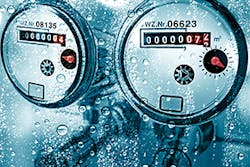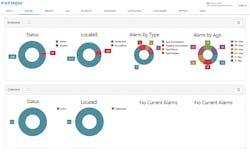Water utilities throughout the US struggle with declining resources and growing populations. Declining supplies and aging infrastructure also make delivering reliable, clean water a challenge.
Building new water sources as a way to meet the challenge of declining resources is difficult and expensive, points out Trevor Hill, CEO of FATHOM, a Meter Data Management (MDM) cloud-based software. Unlike other utility services, water utilities have lagged behind in leveraging the power of big data and software technology to drive efficiency and successful operations, says Hill. Rather than build new dams or desalination plants, “there’s a real opportunity to look at the demand side instead of this fixation on supply side in the context of declining resources,” he says. “There is a significant opportunity in mining the data and in driving efficiencies into utilities.”
Global Water Resources Inc. (GWRI) has been a study in the evolution of how smaller utilities can leverage big data. GWRI is a water resource management company that owns and operates water, wastewater, and recycled water utilities. FATHOM was developed from within GWRI. “We determined that it made sense to build a cloud-based system that allowed utilities of any size to connect on to that system and it would provide an opportunity to not only host the data, but provide the high value benefit from data to the whole sector,” says Hill.
Thus, the company developed FATHOM Utility-to-Utility Solutions as a cloud-based geospatial back office billing system for water utilities. It is designed to build economies of scale to the fragmented water utility sector and offer a multitude of benefits. The MDM cloud-based software addresses the need for a means of integrating the various software, databases, business practices, and equipment used in today’s utilities.
Most utilities do not have a smart grid yet, says Hill. “It’s only on about one million meters,” he says. “Ninety-five percent of the market is still somewhere on their journey to get real-time actionable data organized and into their utility.”
Part of the challenge is the fragmentation within the industry. The reason why the water sector is fragmented is because water is heavy, notes Hill. “This is not what most people think but the truth is that in many other sectors, such as in the gas sector and electric sector where electrons are light, they were readily able to consolidate,” he says.
Some of that can be attributed to the fact that the water sector has developed piecemeal over time. Each time a new town was established, it would build its own water utility, points out Hill. Today, there are some 56,000 water utilities in the US and very few of them are connected, says Hill, adding that only 300 of those utilities have more than 30,000 meters. That means the vast majority of all utilities in the US are comprised of fewer than 30,000 meters or fewer than 75,000 people, he adds.
Small utilities tend to lack IT sophistication and sometimes lack capital “and as a function of that, some of the newer data-driven technologies coming available on market are very hard to adopt for these cities because they are small,” notes Hill.
Given the challenges involved in the water utility industry, many water utility managers may come to embrace what for many years they’ve been evading. “Most cities around North America are fully aware that AMI technology—which is reading meters more frequently—is very likely going to be useful to them, but they perceive it to be a high-cost, high-risk, lower-benefit solution right now,” says Hill. The reality is quite the opposite, points out Hill.
“The benefits have been staggering from the deployment of the smart grid in many ways for the utility not only in revenue, but also in the material decrease in costs, material decrease in things like bad debt, and increase in customer delight,” he says. Utilities can start with the basics, leading to location information for their meters, and get the data in one place, he adds.
“Once that is all in one place, time-synchronized, and meters are reading at different frequencies, then suddenly you can start to harvest the benefits of data
for various needs, such as revenue, operations, and customer service,” he says. “The benefits associated with data and water far outweigh the cost of the implementation of the smart grid for water.”
A primary benefit of MDM is rooted in the case where many utilities often don’t have a handle on how many meters are in their jurisdiction or the condition of those meters. Historically, utilities have lost track of meters for several reasons: a change in property ownership, meter degradation, and new construction. Physical assets don’t match the logical assets, notes Hill. With the billing system not perfectly matching what’s in the field, automation ensures billing coverage of all meters in a jurisdiction, leading to new revenue, which essentially encompasses potential revenues that had existed undetected for a period of time.
Putting all of those meters into a system that manages them from a geospatial perspective, water utility managers can figure out exactly how many meters they have, where they are and their condition, says Hill. “Capturing all of the meters in the system and making sure they’re in good shape generates between 3 and 25% increases in revenue without having to increase rates,” says Hill. “That’s low-hanging fruit, it’s quite simply accomplished and it’s a significant benefit for the city.”
Economies of scale in less expensive and more highly automated back office processes are another benefit. One example: customers are able to pay bills online. That leads to a third benefit of giving customers better tools that enable them to have better insights into their own data. The bottom line: a decrease in the cost of utility operations.
Drought is a significant driver for improvement in water utility operations. Many of GWRI’s partner utilities are located in California and Texas where water conservation efforts are critical. “People generally want to do the right thing and use less water,” contends Hill. “The problem is they don’t know how much they’re using on a given day.”
That’s in contrast to the telecommunications industry in which a customer may get a text message from the telephone company indicating data usage is about to exceed what is covered in a given plan, with increased usage potentially costing the consumer more money. FATHOM, for instance, was designed with alerts and alarms that provide actionable information such as, for example, a customer’s water usage reaching 60% of the conservation threshold or that $100 worth of water has been used on day 15 of the billing month.
The ability to manage data not only helps utility managers, but offers customers insight into real-time actual usage in contrast to other customers or against the backdrop of conservation thresholds set up by the city. Thus, they can manage their own water use behavior or become aware of matters such as leaving a hose running.
MDM is important, given that some 25% of all water pumped into distribution systems is lost in non-revenue water or leaking, points out Hill. “After a utility figures out where all of the meters are, the next task is to tackle where the non-revenue water is going,” he says. “In some cases, it’s running through a meter, but the meter isn’t registering correctly or fully. That’s lost revenue to the city.
“In other cases, there are leaks in the systems that can be pinpointed in context of data. Suddenly, cities can take their non-revenue water from 15 or 20% down to 2 or 3%. That’s just a function of understanding where that water is geospatially and in the context of time.”


